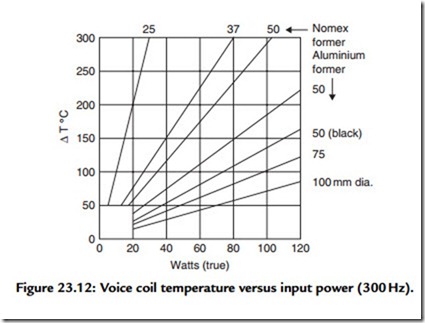Voice Coil
The dimensions of a voice coil are determined primarily by the rated power handling of the loudspeaker. It must be emphasized that with direct radiators, 95–99% of the input electrical power is dissipated in the form of heat; even with the most efficient horn loaded units a minimum of 50% is used for heating purposes only. Figure 23.12 shows voice coil temperature versus input power. The limiting temperature is set by:
1. Maximum temperature rating of the former: 100°C for paper-based materials; 150°C for “Nomex,” which is an aromatic polyamide; 250°C for polyimide;
2. Temperature rating of the wire enamel: maximum 220°C for ML insulation, down to 110°C for self-bonding and self-fluxing wires;
3. Adhesive; from 110°C for cyanoacrylic to 250°C for those with polyimide base; and
4. Mechanical expansion of the voice coil diameter at elevated temperatures.
Fortunately, there is in-built semiprotection for the assembly, namely temperature coefficient of resistance of the wire, which is +0.4% for a 1°C rise in temperature! Thus at a temperature of +250°C above ambient, the voice coil resistance has doubled, and for a constant voltage input (which is the norm for modern amplifiers), the indicated power E2/Rnom is twice the actual power. Note that Rnom is the manufacturer’s specified resistance and is, or should be, the value at the series resonant frequency Rco where the input impedance is minimum and resistive.
